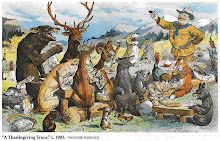Why don't you call it Scat meriwether?...
nationalgeographic.com
I have read numerous journals from 19th century explorers, fur trappers, and government officials for my research project with American Prairie Reserve this summer (previous posts here and here). The hope was that these sources would provide anecdotal insights into historic wildlife populations from Montana's prairie ecosystem.
In fact, these sources have been indispensable to my project by providing vivid, quotable descriptions of the landscape and wildlife. However, these sources also present several problems related to interpretation. This post shares some of the more interesting examples I have encountered.
I spent more time examining the journals of Lewis and Clark than any other sources. They take MANY liberties with spelling, terminology, and grammar. The following sentence about grey wolves is representative of their writing style: "we scarcely see a gang of buffaloe without observing a parsel of those faithfull shepherds on their skirts in readiness to take care of the mamed and wounded." These misspellings are easy to understand. It is more difficult to decipher the different names that explorers used for animal species.
Lewis and Clark often mistakenly refer to pronghorn antelope as goats or deer. In addition, they, as well as most other early explorers, use the term wolf for both grey wolves and coyotes. Sometimes coyotes are distinguished from grey wolves by the name "prairie wolves."
The grizzly bear seemed to cause more nomenclature problems than any other animal. The explorers document black, brown, red, white, grizzly, grey, and sometimes just "large bairs" throughout their expedition. It is particularly problematic when they call an animal a black bear, because they may have been referring to the species Ursus americanus, which is highly distinct from grizzly bears, or they simply may have been referring to the color of the bear.
"Weapons and physiognomy of the Grizzly Bear" by George Catlin, 1846-1848. Source: Smithsonian American Art Museum.
However, on May 22, 1805, Lewis has a revelation and proclaimed, "I believe that it is the same species or family of bears which assumes all those colours at different ages and seasons of the year."
Lewis and Clark's journal entries on bears pose yet another interpretive problem. The explorers frequently refer to bear "signs," which most scholars have interpreted to mean feces. The writers never once mention scat or feces to clarify the meaning of "signs," perhaps because it would have been considered an improper subject in society at that time.
Clark's journal sketch of the bighorn sheep (enlarged to show detail). Source: Smithsonian National Museum of Natural History.
Despite the mistakes or inconsistencies, the journals I read are still excellent sources of information on the Western landscape before white settlement. The Corps of Discovery contributed a great deal to the scientific knowledge of our country. Elliot Coues, editor of the 1893 edition of the journals claims, "The grizzly bear is the most notable discovery made in zoology by Lewis and Clark." The expedition is also credited with "discovering" pronghorn antelope, bighorn sheep, mule deer, prairie dogs, kit foxes, and numerous birds like the greater sage grouse – although Native Americans had known these species long before explorers arrived.
The amount of observational data recorded in the journals of Lewis and Clark is remarkable given the pace of their expedition, frequently amounting to 20 miles a day. Though it is often difficult to deconstruct and synthesize information from these journals, both the greatest struggle and reward of doing historical research is the requirement to interpret.
Recommended reading: Paul Schullery's Lewis and Clark Among the Grizzlies
American Prairie Reserve intern Michelle Berry is a Master's student in environmental studies at Stanford. She has been tasked with examining historical works of literature and other primary sources to establish wildlife population estimates in the Reserve region of northeastern Montana. Her 10-week internship was made possible by the Bill Lane Center for the American West.









No comments:
Post a Comment